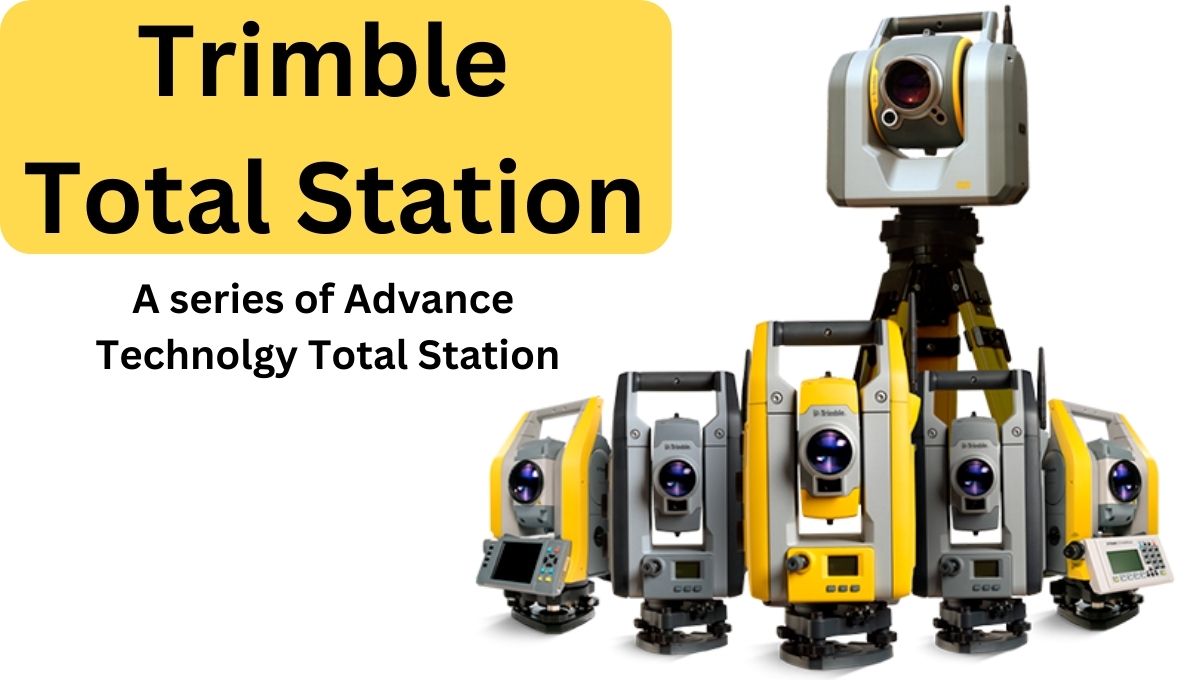Trimble total station is a renowned manufacturer of advanced surveying and positioning technology. The total stations are known for their accuracy and reliability. These instruments integrate electronic theodolites and E.D.M technology to capture precise measurements.
This total stations are widely used in industries such as land surveying, construction, engineering, and archaeology. With a strong global presence and a commitment to customer satisfaction, It continues to lead the way in surveying and positioning technology.
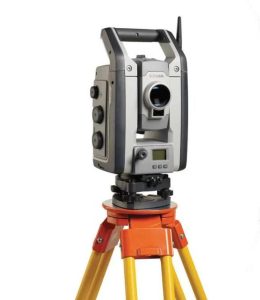
What Does the Trimble Total Station Do?
The total station is a sophisticated surveying instrument that combines electronic theodolites and electronic distance measurement (E.D.M) technology. It is designed to accurately measure angles, distances, and coordinates in three-dimensional space. The total station utilizes advanced optics, precise E.D.M technology, and integrated software to facilitate accurate and efficient data collection in surveying and construction projects.
With a total station, surveyors and professionals can precisely locate points, objects, and features on the ground. It enables them to measure angles horizontally and vertically, as well as distances to targets, including reflective prisms. The total station’s E.D.M unit emits a laser or infrared beam to determine distances with high accuracy.
In addition to measuring angles and distances, it can also store data, perform calculations, and connect with external devices such as data collectors or computers. This integration allows for real-time data processing, visualization, and analysis, enhancing productivity and accuracy on-site.
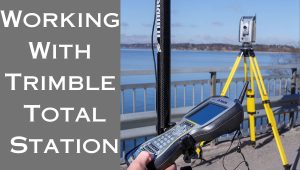
The total station plays a crucial role in various applications, including land surveying, construction layout, infrastructure development, mapping, engineering projects, and archaeology. It provides professionals with the necessary tools to collect precise measurements, create accurate maps, and ensure proper alignment and positioning of structures and elements.
Overall, the total station serves as a versatile and powerful tool for surveyors and professionals in the Geo spatial industry, enabling them to gather essential data and perform critical tasks with high levels of accuracy and efficiency.
What are The Types of Trimble Total Stations?
The total station offers a wide range of instruments, each designed to cater to specific surveying and construction needs. Here are the four main types.
Reflector less Total Stations.
Reflector less total stations are equipped with advanced laser technology that allows them to measure distances without the need for a reflective prism. These total stations emit a laser beam that reflects off the target and calculates the distance based on the time taken for the beam to return.
Reflector less total stations are ideal for scenarios where a direct line of sight to the target is not possible or when accessing hazardous or hard-to-reach areas.
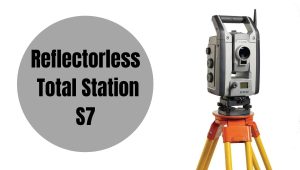 Robotic Total Stations.
Robotic Total Stations.
Robotic total stations are designed for single-operator surveying, offering increased productivity and efficiency. These total stations are equipped with automated tracking capabilities, enabling them to automatically track a prism or reflector target.
With a remote control or data collector, the surveyor can operate the instrument and perform measurements from a distance, reducing the need for manual adjustments and multiple personnel on the field.
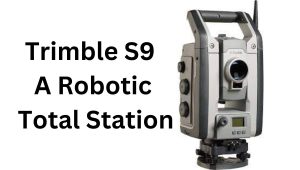 Manual Total Stations.
Manual Total Stations.
Manual total stations are traditional surveying instruments that require manual aiming and adjustment by the surveyor. These total stations are operated by physically aligning the instrument to the target and reading the measurements directly from the instrument’s display.
Manual total stations are typically used in smaller-scale projects or in areas with a clear line of sight, where the surveyor has more control over the positioning and aiming process.
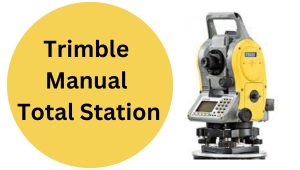 Motorized Total Stations.
Motorized Total Stations.
Motorized total stations combine the functionalities of robotic and manual total stations. These total stations offer both automated tracking capabilities and the flexibility for manual operation. They provide the convenience of robotic tracking when needed, but also allow surveyors to manually aim and adjust the instrument when specific requirements arise.
Motorized total stations offer versatility and ease of use, making them suitable for a wide range of surveying and construction applications.
It’s important to note that Trimble may have additional variations and models within these categories, each with its own set of features and capabilities. Professionals should choose the type of total station that aligns with their specific project requirements, considering factors such as the level of automation needed, the complexity of the site, and the desired precision and efficiency of measurements.
The Versatile Uses of Trimble Total Stations.
The total stations are versatile tools that find applications in various industries and disciplines. Here are some of the versatile uses of total stations.
Land Surveying.
Trimble are widely used in land surveying applications. They play a crucial role in conducting boundary surveys, topographic surveys, cadastral mapping, and geodetic control surveys.
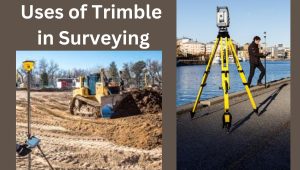
Land surveyors rely on Trimble total stations to accurately measure angles, distances, and coordinates, enabling them to establish property boundaries, create detailed maps, and gather essential data for land development projects.
Construction.
In the construction industry, it plays an essential tools for layout and setting out tasks. Construction professionals utilize total stations to precisely position elements such as buildings, roads, bridges, utilities, and other infrastructure features.

The total stations ensure accurate alignment and placement of construction elements according to design plans, minimizing errors and optimizing project efficiency.
Engineering.
The total stations have numerous applications in the field of engineering. They are used for monitoring structural movements, conducting deformation analysis, and verifying construction quality. Engineers rely on total stations to measure and monitor the performance of structures such as bridges, dams, tunnels, and buildings. These measurements help ensure structural integrity and safety, as well as provide valuable data for analysis and maintenance purposes.
Archaeology.
Archaeologists employ these instruments to conduct precise site mapping, documentation, and excavation. Total stations enable accurate recording and measurement of artifact locations, excavation grids, and site features. This data aids in creating detailed archaeological maps, documenting archaeological sites, and analyzing spatial relationships between artifacts and structures. The total stations offer the precision and accuracy required to preserve and study archaeological sites effectively.
Environmental Monitoring.
This instrument is utilized in environmental monitoring projects to measure and track changes in the natural environment. These instruments are used to monitor coastal erosion, vegetation growth, and land subsidence. Total stations enable scientists and environmental professionals to capture accurate data over time, contributing to the understanding of environmental changes and facilitating effective management and conservation efforts.
Mining and Quarrying.
This instrument are employed in mining and quarrying operations for tasks such as stockpile measurements, volume calculations, and high-precision mapping. Total stations provide accurate measurements of stockpiles, ensuring efficient inventory management. They also aid in the creation of detailed mine plans, slope monitoring, and optimizing extraction processes.
Moreover, Trimble total stations offer professionals in various industries the ability to collect precise and reliable spatial data. Their versatility, accuracy, and advanced features make them indispensable tools for a wide range of applications, providing essential measurements and data for informed decision-making and efficient project execution.
Conclusion
Trimble total stations are essential tools in surveying, construction, engineering, and other industries. They provide accurate measurements and reliable performance, empowering professionals to make informed decisions. this total station commitment to innovation and customer support ensures their total stations are user-friendly and integrated with advanced software. With a global network of dealers, It leads the industry, revolutionizing spatial data gathering and enhancing productivity.
